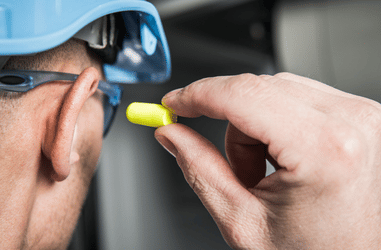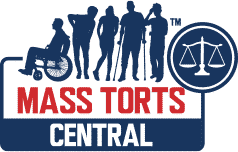What Was the Defect in the 3M Earplugs?

If you have been following the hearing loss litigation for military veterans, you may be wondering what 3M earplugs were defective and what the issue was. The defect was found in the Combat Arms Earplug Version 2 (CAEv2) product, and thousands of military service members claim they suffered hearing loss after the earplugs’ dual-ended design did not offer sufficient hearing protection for their ears.
Many of the military personnel who wore the earplugs saw active combat duty in Afghanistan and Iraq. After repeated exposure to loud explosions, munitions, and heavy machinery, hundreds of thousands of military veterans may have suffered hearing damage due to defects in the 3M Combat Arms earplugs.
Defects with the Yellow Side of the 3M Earplugs
Aearo Technologies (Aearo) created the dual-ended earplug. The design was supposed to block out sounds completely when inserted in one direction but allow certain sound levels when inserted the other way. Aearo claimed the yellow side of its earplugs would allow a 0-decibel rating as specified by the government. The company told government military personnel they would be able to hear spoken words by colleagues yet be completely protected from loud sounds, such as explosions and firearms.
In 2008, 3M bought Aearo Technologies and continued to supply the military with the earplugs. Moldex-Metric (a competitor producing a similar product) filed a lawsuit against 3M. Moldex tested the earplugs and found they had a rating of -2. Contrary to blocking sound, this rating meant users had sounds amplified in their ears, the opposite of their intent.
Defects with the Green Side of the 3M Earplugs
Additional claims found problems with the green side of the dual-ended earplugs, too. Lawsuits claim the manufacturer deliberately falsified the earplugs’ decibel rating. This defect means the product would never protect users’ hearing from the constant loud sounds military personnel would experience in combat situations.
Design Flaw with the Combat Arms V2 Earplugs
The biggest problem with the Combat Arms earplugs is their size. Both the ends of the device’s ear stems are too short. Users cannot insert the earplugs far enough into their ears to give them the hearing protection they need.
The earplugs have a large flange that prevents users from completely penetrating their ears. Over time, the earplugs loosen slightly, resulting in sound being able to seep in, damaging users’ sensitive eardrums.
3M attempted a quick fix of the flange problem. The flanges would roll back onto the opposite end of the ear stem while the other end was inserted in the wearer’s ear. However, 3M never provided users with clear instructions to roll this flange back. This resulted in thousands of military personnel having no idea of this attempted “quick fix” of the earplugs’ design flaw.
3M Defective Combat Earplugs Lawsuit
In the military, exposure to loud sounds from munitions, explosions, and heavy machinery is common. But personnel also needed a way to communicate with each other while still protecting their hearing from the loud sounds. Aearo Technologies’ dual-ended earplugs were meant to be a useful innovation for military personnel and other persons exposed to repeated or constant loud sounds.
The company’s “Combat Arms Earplug, Version 2” was its solution to the hearing protection/communication problem. If the earplugs were inserted in one direction, all sound was supposed to be blocked out. Inserting the earplugs in the other direction was supposed to allow users to hear colleagues’ spoken words while blocking the loud explosions and weapons fire during combat and training exercises.
The Military Contract
Starting in 2003, the United States government contracted Aearo Technologies to supply its military branches with the earplugs. Although all branches would receive the devices, ultimately, the U.S. Army would receive the lion’s share.
Every year, 3M was contracted to send the military bulk orders containing 15,000 packages of earplugs. Each package contained 50 pairs of earplugs. Over the years, military veterans began complaining of hearing damage due to the 3M earplugs failing to adequately protect their hearing.
3M Buys Aearo Technologies
After buying Aearo Technologies in 2008, 3M continued to provide the U.S. military with thousands of earplugs each year. Many personnel in active combat zones, including Afghanistan and Iraq, used the earplugs.
Moldex-Metric Files Suit Against 3M
On behalf of the U.S. government, manufacturer Moldex-Metric sued 3M, alleging the company’s earplugs were defective. The lawsuit claimed these defects would cause users to suffer permanent hearing loss or impairment.
Moldex’s lawsuit was a “False Claims Act” lawsuit, alleging 3M knew of the earplugs’ flaws but continued selling them anyway. 3M decided to settle the $9.1 million suit out of court in June 2018. 3M representatives said at the time that there was nothing wrong with their product and only settled out of court to avoid more potentially damaging publicity.
Over 200,000 Lawsuits Filed
Ex-military personnel make up many of the 200,000-plus lawsuits 3M is now facing. The plaintiffs claim the defects in the earplugs led to them experiencing tinnitus, hearing loss, hearing impairment, and a loss of life enjoyment.
Trials concerning the 3M earplugs were postponed in 2020 and part of 2021 because of the ongoing COVID-19 threat. Partly through 2021, many court systems reopened, and trials began. 3M has seen its share of courtroom defeats but has also been awarded not guilty verdicts in multiple trials.
Will There Be a Global Settlement for 3M Lawsuits?
So far, 3M has not initiated settlement talks. Some legal experts believe the company’s multiple courtroom victories have motivated 3M decision-makers to forge ahead with more individual trials. The individual trials that have taken place are “bellwether trials.” Sometimes, a company faces thousands or hundreds of thousands of lawsuits stemming from a defective product. When companies are facing this many lawsuits related to one product, they often elect to try a few individual cases in court.
3M’s cases allowed it to gauge what it could face in future trials. In past instances, companies that suffer several significant courtroom defeats in a row often decide to discuss global settlements with plaintiff attorneys. If the defendant company is victorious in several cases, its representatives may feel confident with additional individual trials.
How Global Settlements May Save Time and Money
Product liability cases numbering in the thousands are called “mass tort cases.” Because there are so many plaintiffs, these cases can be very complicated. Significant research and preparation must be done for each case. The defendant’s attorneys may also use motions and delaying tactics to drag out litigation on a single case for years.
To help their clients seek justice faster, some attorneys elect to negotiate global settlements. In these cases, parties save substantial time and money. Much of the trial procedure can be avoided. Both sides come to the table to negotiate a settlement to compensate all plaintiffs’ lawsuits against the company. Plaintiffs can either agree to the settlement amounts agreed upon by both parties or opt out of the settlement and try their hand in an individual trial.
Veterans Report Various Hearing Issues After 3M Earplugs Use
Users say they experienced different kinds of hearing impairments after using 3M’s earplugs. Some military personnel have had these issues while still on active duty. Other problems became apparent years after veterans concluded their service.
Most commonly, victims complain of permanent hearing loss or hearing impairment. Below are some of the other common issues 3M earplugs users may experience.
Auditory Processing Disorder (APD)
The human brain must be able to detect the nuances in human speech. Many sounds are similar. When the capacity to distinguish between these subtle differences is taken away, victims may hear sounds very clearly. But their brain can no longer discern what exactly is being said. Known as auditory processing disorder (APD), this condition affects how your brain understands speech.
Acoustic Neuroma
The main, or vestibular, nerve from a person’s inner ear connects to the brain. Your ability to balance and hear sounds is affected by branches of this nerve. A slow-growing, non-cancerous tumor sometimes develops on your inner ear’s main nerve. The pressure from this tumor may lead to hearing loss. You may also suffer from unsteadiness and hear a ringing in your ear. This condition is called acoustic neuroma.
Neurofibromatosis
Normally, this condition is genetic. Your parents can pass it on to you via your genes, but sometimes your genes can mutate, causing the condition. Neurofibromatosis refers to tumors growing on the nerves of your nervous system. These tumors are usually benign but can sometimes be cancerous.
Conductive Hearing Loss
If you have difficulty hearing soft sounds, you may have conductive hearing loss, meaning sounds can’t reach your inner ear.
Sensorineural Hearing Loss
This condition is permanent, though it may vary in severity. When the tiny hairs in your inner ear are damaged, you suffer hearing loss. This kind of hearing loss also occurs when there is damage to the nerve pathways connecting your brain to your inner ear.
Auditory Neuropathy
An extremely rare kind of hearing loss occurs when the nerve impulses sending information from your inner ear to the human brain are damaged. Some experts call this type of hearing loss nerve deafness. Currently, no cure exists.
Like other conditions on this list, auditory neuropathy can vary greatly. Sometimes, the person suffering from this condition can hear sounds but not understand spoken words. This may be pronounced in loud environments.
The prognosis for this condition can also vary greatly. Some patients see their condition improve. Others notice their hearing deteriorate or remain the same. Medical science cannot currently determine what causes the condition to change in one patient yet remain the same in another.
Tinnitus
Military personnel who suffered hearing damage stemming from their use of the 3M earplugs most often complain of this condition. Tinnitus simply refers to a ringing in your ears. The condition can happen in one or both ears. While you can hear this ringing sound, no one around you can.
About 15%-20% of the population is affected by this condition. It is especially common in older adults. But for 3M earplug users, tinnitus is all too common.
You Can Consult a Lawyer About Defective 3M Earplugs
If you suffered hearing damage from wearing defective 3M earplugs, you may be entitled to seek financial compensation from the company. Some military veterans wonder if filing a claim against 3M will impact their VA benefits. Fortunately, you are eligible to receive both types of compensation. If you have hearing problems, you may qualify for a monthly payment on top of any payout you seek from a 3M lawsuit.
When a person suffers because of a company’s negligence, it is understandable to want or expect financial compensation for damages. These plaintiffs often find a product liability lawsuit to be difficult for many reasons.
Large corporations hire lawyers who understand the details of the law. They know how to stonewall, obscure facts, or otherwise help their corporate clients avoid compensating users for their client’s defective products.
How a Product Liability Lawyer Can Help You
A 3M earplug lawsuit attorney can explain your legal options to you. After conducting a thorough investigation into your case, a lawyer can explain your case’s potential value, help you prepare your lawsuit, and guide you along your path to seek justice. Many product liability lawyers are committed to helping victims of defective or dangerous products.
Negligent corporations sometimes release products, knowing they are potentially harmful. Consumers like you suffer, believing the company was held to safety standards before the product was released. You can fill out our contact form for a free, no-obligation case evaluation or call 1-844-448-6787 for a free consultation.
